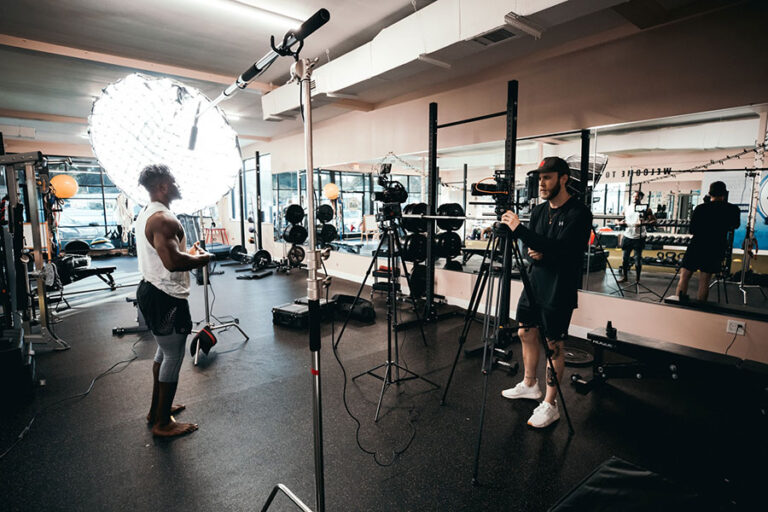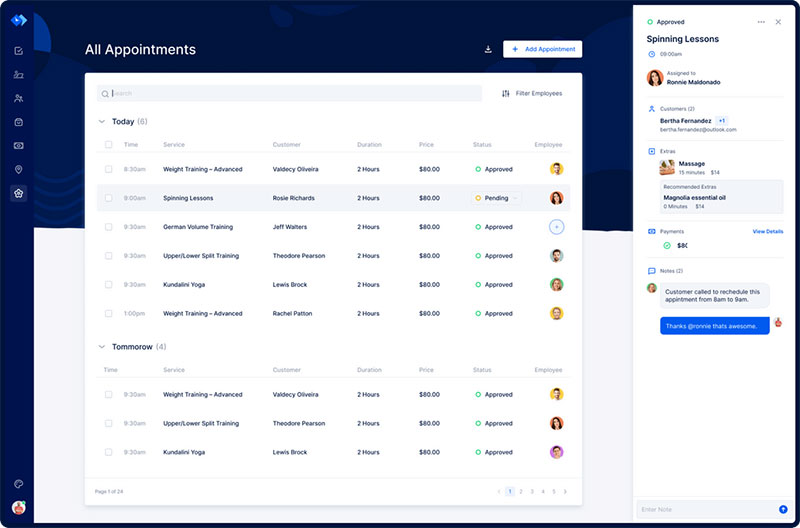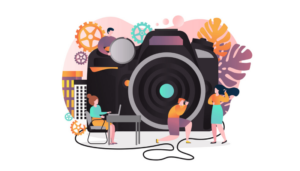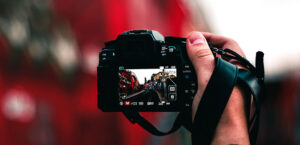Quality pictures impact their viewers. Fitness professionals use pictures to motivate and inspire others. Many people admire fit individuals, especially when they see a quality photo of them.
How can fitness photographers take great photos of fit individuals? As with any photo, it takes planning, preparation, and cooperation.
The photographer needs to set up the right background, get the right equipment, and properly pose the model. As with every photoshoot, the photographer needs to make effective use of light. Lightroom sport presets could be of great help.
This article will discuss fitness photography tips that help fitness photoshoots run smoothly.
Who Needs a Fitness Photoshoot?
There are a wide variety of situations where a fitness photoshoot is necessary. So who needs a fitness photoshoot?
Fitness Coaches
Personal fitness coaches need pictures to build up their brand. They most likely have a website and presence on Instagram, Facebook, LinkedIn, etc. They need quality pictures to post on these platforms and appeal to potential clients.
Fitness Models/Influencers
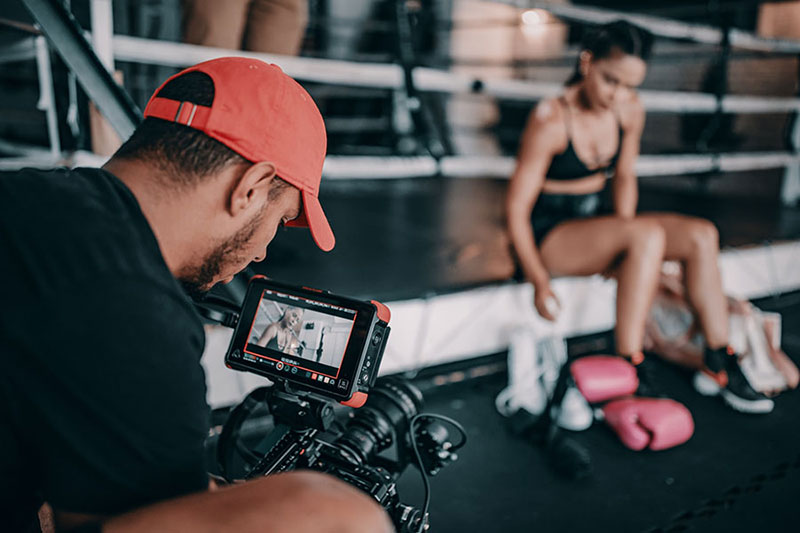
Models who represent fitness gear and brands also need fitness photoshoots. They need to show that they represent the fitness brand well.
Influencers on social media may also need a fitness photoshoot. After a person attains a large following, companies will reach out to them and offer sponsorships. They need pictures that appeal to fitness brands if they want those companies to reach out to them.
Athletes
Professional and amateur athletes also need fitness photoshoots to gain popularity and sponsors.
Those Who Have Lost Weight
Other people who might be interested in a photoshoot are people who have lost weight. Some who have worked very hard to lose that weight want to celebrate their success by taking photos of their new body.
Fitness Photography Tips
The purpose of a fitness photographer is to capture the strength and health of the model. A good goal is to make the person look like they belong on the cover of a wellness magazine. Here are a few tips to accomplish that goal:
Prep Work
Write Down the Shots
Planning and preparation are keys to success in a photoshoot. Photographers need to think ahead to avoid wasting time while getting the best fitness photos.
The first thing fitness photographers should do is write down the shots they need. They should describe them in detail and think about how to do them.
During a photoshoot, it is easy to get overwhelmed with all the activities. Writing down the shots needed ensures that nothing is forgotten. It also saves money because it means doing the photoshoot only once.
Thinking ahead about how to approach the shots saves time. As soon as they step foot in a fitness photoshoot, photographers will know exactly what to do and not waste time thinking about how to approach it.
Take Test Shots Before the Shoot
Practice makes perfect. This is especially true with photography. To take impressive fitness photos, make sure to take test shots.
Test out the lighting of the photoshoot location and different model poses. Gyms do not have the best lighting for photos. So take a few test shots in different locations around the gym to find which spot is best for the photoshoot. Or you might realize that you need a flash or strobe lighting.
Testing out the location before the photoshoot will help you get the right equipment for the job. It will also help you know which is the best spot for the model to stand.
Communicate with the Model
Even with the best camera and lighting, a good photoshoot depends on the collaboration of the model and photographer. So, communicate with the model to get the best results.
Tell the model what style you want in the photos. Bring some sample photos of good fitness poses. Both will help the model feel more confident and allow the photographer to capture the desired photos in less time.
If the model is an athlete or a fitness expert, make sure to listen to their advice. Photographers know how to take a good photo, but the fitness expert knows what appeals to the target audience. Ask them for feedback on ways to improve the fitness photos.
Another good idea is to learn the story behind the athlete or fitness expert. The backstory can spark ideas about the location, props, and poses of the photoshoot. It will help you take photos that are authentic to the athlete’s fitness story.
Bond with the athlete. Understand what they are comfortable with and what their favorite poses are. Being in tune with the model will create a better environment for taking great photos. It will also help capture more natural photos that look great on social media platforms or in magazines.
Model Poses
Make the Model Do the Work
Pretending to exercise comes across in photos. To capture the best fitness photos, make the model actually do the work. It will make the images look natural. A shot of an athlete sweating, breathing heavily, and making the appropriate facial expressions can make all the difference.
A word of caution, though: make sure that the model does not overdo it. Do not push them to hold a pose to the point of injury. It is better for a model to perform the activity five times over than to do it once and get injured.
Be adaptable. Let the models choose which poses they like the best. Do not overdo it, and make sure to create an environment where the model feels OK saying “no.”
Tweak the Pose
Of course, sometimes athletes perform tasks in ways that are not very appealing to the camera. For example, a marathon runner may run in a way that saves energy but does not look good on camera.
So a photographer can have the athlete do the activity, but they can also request some tweaks to create a better photographic angle. The tweaks should maintain authenticity but result in a more powerful image.
Photographers need to give clear and simple directions. The photographer can direct the model on things like:
- Where the models should look
- What facial expression they should have
- How long their stride length should be
- How fast they should go
- Where they should plant their feet
- Where they should place their hands
- How they should bend their elbows
- The direction they should move their arms or legs
Keep the Model Moving
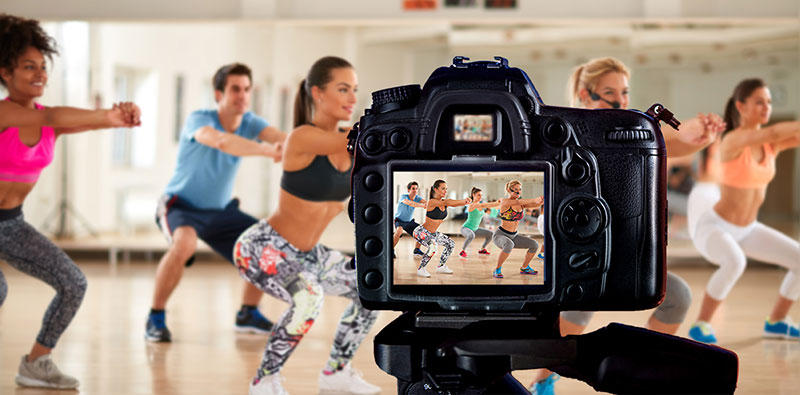
Even a static pose can include movement to capture a moment of action. Make sure that the model keeps moving and does not settle into one pose.
When someone does settle into a pose, the expression changes. For example, a model could drop into a lunge or a downward dog. After a while, the muscles will relax, and their skeleton will hold up their body weight. This is contrary to the fitness shot’s intention and would not reflect an accurate image of the exercise or the athlete.
Instead, a model and a photographer should plan a mini flow of workouts that the athlete can move through. This provides various photo opportunities and creates a more accurate image.
Additionally, when models hold a pose, they can still make small movements to create a more actionable photoshoot. They can switch their weight to their feet or hands. Or they can change the direction they are looking.
Try Candid Photos
Candid photos are a great way to show the athlete’s true personality. To get candid photos, help models to relax and to be themselves. Make them feel comfortable so that they forget about the camera. But keep clicking the button to capture their true essence.
Use Facial Expressions
It is human nature to judge photos based on facial expressions. Plus, adding facial expressions to a photo adds a higher quality to it. Here are some expressions to consider for a fitness photoshoot:
- A smile. People associate smiling with positive attributes like friendliness and happiness.
- Use eyes to express the determination of an athlete.
- An emotion most people feel while giving their all to fitness activities.
- Although fitness is strenuous, it provides a unique feeling of satisfaction.
Magnify the Muscles
In fitness photography, the main focus of the picture is the body. So photographers can use a few tricks to enhance it. For example, they can use oil to make the body shine. Or they can have the model pump up their muscles to maximize the effect.
Get the Lighting Just Right
Use Low Lighting
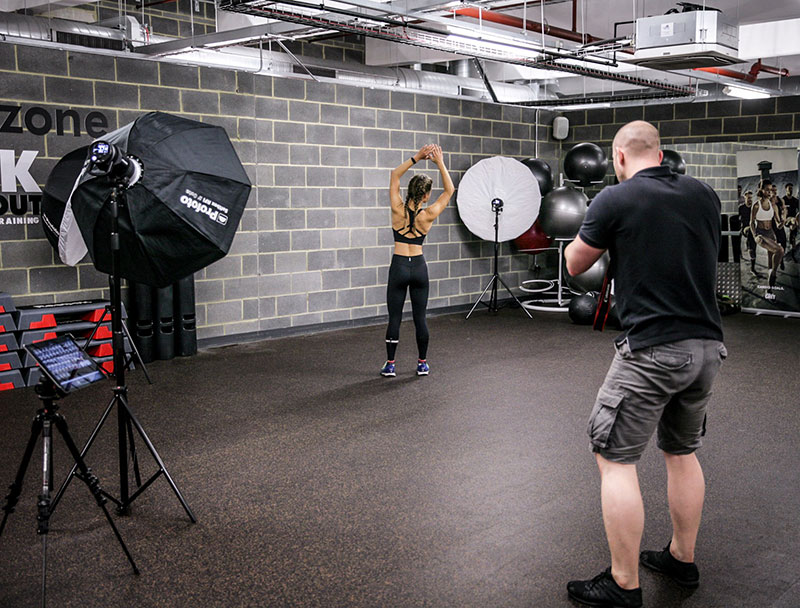
Fitness photography should emphasize the physique of the model. Light plays a major role in how the model appears. Using low-key lighting instead of high-key will help create the perfect fitness photo.
Instead of lighting everything, photographers should use streaks of light and shadows to their advantage. Shadows make muscles more visible and add a deeper perception to the photo.
Photographers should adjust the light so that it does not hit the model directly but diagonally. If photographers do not have the proper equipment to create this kind of lighting, they can use natural light. For example, they can use the light from a window.
Shoot Near a Window for More Flattering Light
The natural light from a window is a favorite source of light for all photographers. A large window provides an opportunity to create direct light, side light, or backlight. It allows for a lot of variety in the pictures.
It is an excellent method for exercises that require equipment, but it also works great for exercises that don’t, like yoga. The light from a window can be controlled. Use netting or reflectors to diffuse light and create gentle and soft tones.
Adjust the Exposure Manually
Most professional photographers like to control the exposure of their photos. The automatic exposure setting does not usually create the right shadows on the model.
So, to get the proper exposure, set it manually. Make the photo slightly darker than reality. This helps emphasize the light shining on the body.
To darken the photo, increase the shutter speed or reduce the aperture. Keep the ISO value as low as possible. Learn more about your camera and how to control the exposure manually to capture the best photos.
Play with Natural Light
If the photoshoot is outside, the photographer will need to play with the natural light to get the right look. The best time for an outdoor photoshoot is about an hour before the sun goes down. The light is lower at that time and does not create sharp shadows.
Here are a few ways to position a model outside:
- Do not face models directly at the light (the sun). This will create dark shadows and will make the image look flat. Place models so that the curves of the muscles are prominent. Standing sideways accomplishes that look. If possible, have them stand sideways against a white or grey background wall.
- Another way to position models is with the sun behind them but outside of the image area. This will create a rim of light that outlines the model’s body from the back.
There is also a way to play with natural light indoors. Take a reflector like a white bed sheet or white cardboard and place it underneath the model out of the frame. The reflection will make light hit the model more evenly. Then take the photo with your back to a window to reduce glare.
Get the Right Angle
As mentioned before in this guide of fitness photography tips, the angle of the shot matters. The angle of the light hitting the subject and the pose angle determine what is emphasized in the photo. Straight-on light flattens out the muscles.
To highlight muscles, angle the light so that shadows cross over the muscle and give it dimension. To create this effect, turn the model away from the light source, whether the sun, a window, or a light fixture. According to an expert fitness photographer, the light that shines up and to the side is most flattering for male models.
Get more bookings with the right tool for the job
Staying organized has never been easier.
You can now manage your business and grow your brand with a single, powerful software that keeps all of your appointments in line, your clients organized and your business booming.
Trafft is perfect for business owners who need to streamline their booking experience both for their staff and their clients.
Trafft handles everything for you, even sending automated email or SMS reminders to your clients. No-shows? Not anymore!
The Trafft booking software adapts to different industries for a blissful online booking experience and employee management.
Want to know more? Check out Trafft’s awesome features to see what you are missing.
The Background of Fitness Photos
Location, Location, Location
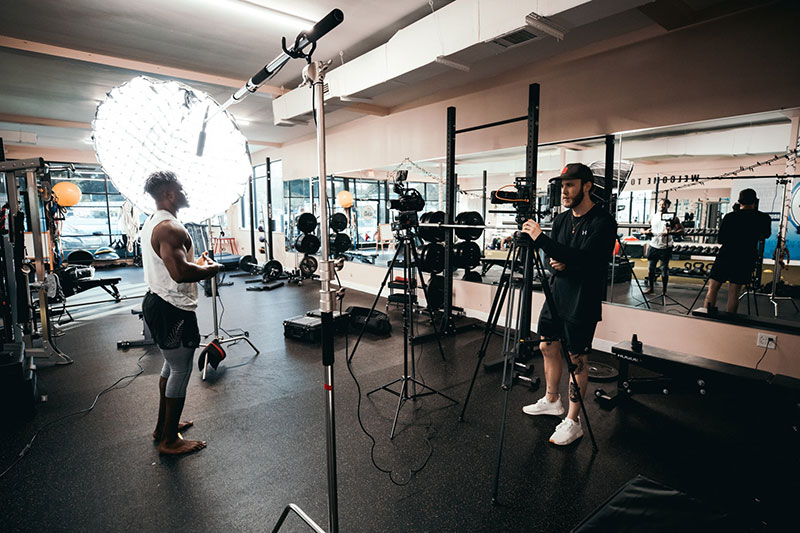
The location of a fitness photoshoot depends on the style and purpose of the pictures. For some, a busy and colorful area matches their story. But, in general, the best background for a fitness photoshoot is a bland one.
For the most part, fitness photography focuses on the model, the muscles, and the exercise. The fewer distractions in the background, the more viewers will focus on the subject. Finding a good location is key.
Look for an open space location with a distraction-free background. Scout out the area for places like empty parking lots, parks, fields, the back of buildings, etc.
Blur Distractions
Another method for creating a good background is to blur distractions. Using a large aperture blurs the background of a picture and makes the main object stand out.
For aperture, the smaller the number, the blurrier the background. An aperture like f/2.8 will blur out background distractions and capture details on the model’s face.
Of course, the aperture you chose depends on your style of shooting. Experiment with different apertures to find the blur/sharpness ratio you like the best.
Fitness Photography Techniques
Frame the Photos
A common photography technique is to frame the subject. This means that the photographer uses an object to create a frame within the frame during the photoshoot. This creative method is used while capturing action.
Photographers can take a picture through an object. Obviously, in this case, it would be a fitness object. If they use a large aperture, the object will look blurred around the outside of the composition. Framing a picture in this way adds a special element to the photo but is not distracting.
Focus on Details
Focusing on details helps make a fitness photoshoot diverse. As the expression goes, the devil is in the details. Focusing on details can make a difference between a good picture and a great one.
Use details to support the storyline. Details include different props, outfits, facial expressions, etc. Although the details can go a long way in making a better photo, do not let them overwhelm you. Take the most important shots first. Then, if you have time, worry about other details.
Some other details include using oil to give the model’s body a shine. Or using a zoom lens to create distance between the photographer and the model.
Use Props
The number of props available for fitness photography is almost limitless. Any exercise equipment can be used as a prop. This includes:
- Treadmills
- Dumbbells
- Jump ropes
- Weights
- Fitness bands
- Yoga mats, and more
There are also other types of props that photographers can use to add a unique look to the photo. These include things like smoke bombs, costumes, flour, and more.
Editing the Photos

Many people debate about whether a photographer should edit his pictures or not. Of course, it is better if you do not need to edit them, but there is nothing wrong with editing.
A photographer might want to make a few edits to improve the picture. Examples of editing include:
- cropping out an unwanted background
- changing the composition
- adjusting the lighting
- adding a tanning effect
Adding a tanning effect to the picture can highlight specific muscles and define features better. It can also cover veins or skin blemishes. Since humans are visual beings, editing the image for a more aesthetic appeal will make the photo more captivating.
Although there is nothing wrong with making a few changes to the photo, avoid over-editing. Editing too much and using filters will take away the photo’s natural look. For the best results, use editing features sparingly.
FAQs about fitness photography tips
1. How can I take better fitness photos indoors?
Because of the constrained space and poor lighting, it can be difficult to take excellent fitness shots indoors.
Yet, you may take stunning fitness photos by choosing a suitable place with adequate natural light, using a tripod to stabilize your camera, and playing with different angles. Another piece of advice is to photograph in RAW and then edit your photos to bring out the colors and details.
2. What camera settings should I use for fitness photography?
You should set your camera to a fast shutter speed of at least 1/500s to freeze motion in order to get clear, excellent fitness shots.
To blur the background and focus on your subject, use a wide aperture of f/2.8 or lower to get a narrow depth of field. Use a low ISO level as well to prevent digital noise in your photographs.
3. How can I pose my fitness model to create dynamic images?
Posing your fitness model can significantly improve your image’s aesthetic appeal. Try out several stances that highlight their abilities and display their physique.
If you want to give your pictures a sense of motion and energy, think about adopting dynamic stances like sprinting or jumping. To give their position a more defined appearance, encourage your model to contract their muscles and their core.
4. What lighting setup is best for fitness photography?
Your fitness photography can succeed or fail based on the lighting settings you use. Preferably, you should use natural light whenever you can because it has the ability to soften and flatter your subject.
Consider using a softbox or umbrella to diffuse the light and provide a similar soft feel if you’re shooting indoors. To add depth and texture to your photos, angle your lighting source such that it is 45 degrees away from the subject.
5. How can I capture action shots in fitness photography?
Fitness photography demands precise timing and a quick shutter speed to capture movement photos. It is important to anticipate your subject’s movements and be prepared to snap the photo when the time is appropriate.
Increase your chances of getting the perfect shot by using burst mode to quickly take several shots. Moreover, experiment with using a telephoto lens to close in on your subject and add drama to your pictures.
6. How can I edit my fitness photos to make them more visually appealing?
By editing your fitness photos, you can enhance their features and colors for a more aesthetically pleasing result. To change your photographs’ exposure, contrast, and color temperature, use photo editing software like Adobe Lightroom.
Think about adding a vignette effect to highlight your topic or sharpening your photographs using a high-pass filter.
7. What are some common mistakes to avoid in fitness photography?
Using bright or unfavorable lighting, neglecting to engage the subject’s muscles and posing them uncomfortably, and failing to pay attention to the basics like proper framing and focus are all common blunders in fitness photography.
Over-editing your photos can produce an unrealistic appearance and take away from the authenticity of the scene, so avoid doing this at all costs.
8. How can I capture the emotion and energy of a fitness session in my photos?
Using a variety of approaches, including dynamic poses, burst mode, and concentrating on your subject’s facial expressions, you may capture the emotion and energy of a workout.
Moreover, think about utilizing a wide-angle lens to take pictures of the surroundings and background so that you may give your pictures context and aesthetic interest.
9. What are some tips for capturing fitness photos in natural light?
For the softest and most pleasing light while taking fitness images in natural light, think about shooting during the golden hour (the hour before sunset).
To avoid severe shadows and direct sunshine, look for open shade, such as a tree or a building. To illuminate your subject and eliminate any shadows on their face or body, use a reflector. Moreover, be aware of the light’s direction and how it impacts the tone and ambiance of your pictures.
10. How can I create a cohesive visual style for my fitness photography portfolio?
Color scheme, composition, and editing style are just a few of the components that go into developing a visually appealing visual style for your fitness photography portfolio.
Think about selecting a color palette that complements the tone and subject matter of your images. To make your image compositions balanced and eye-catching, use the rule of thirds.
Moreover, to establish a unified and professional appearance throughout your portfolio, think about using a consistent editing technique, such as a film-like filter or a desaturated effect.
Ending thoughts on fitness photography
However, a photographer wants to use their creativity is up to them. This guide simply lists a few fitness photography tips that can help improve a photoshoot session.
The most important thing is to be flexible and to keep practicing. Do some prep work to avoid overwhelming feelings during the shoot. Collaborate with the model and ask for feedback. Pay attention to lighting.
With patience and practice, you will be able to take great fitness photos in no time at all.
If you enjoyed reading this article on fitness photography tips, you should also read this one about real estate photography marketing.
We also wrote articles about similar subjects like how to get more photography clients, becoming an event photographer, how to become a licensed photographer, social media marketing for photographers, real estate photography contract, appointment scheduling for real estate agents, how to get your photography noticed and photography mood board.
